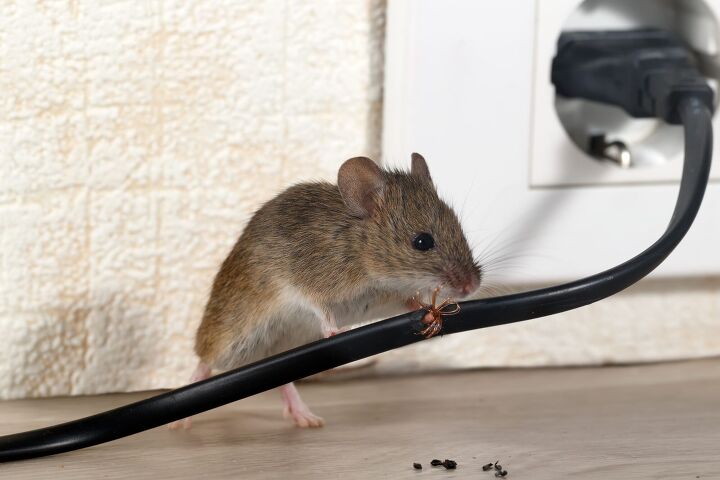How To Get Rid Of Rats In Walls And Ceilings

Imagine drifting off to sleep at night and hearing scurrying and scratching sounds. It’s undoubtedly unsettling, to say the least, when you know you have critters living within your walls. Understandably, you want to know how to get rid of rats in the walls and ceilings once and for all.
Seal all holes, cracks, and other entry points to your home and set up rat traps. Rat poison is an option, and you can bait various traps with items like berries, nuts, and peanut butter. Electronic traps make clean-up easy or use ultrasonic devices to deter rats from entering or remaining in your home. The best step is to use a professional pest management company.
There’s nothing fun about discovering rats in your walls and ceiling. They cause damage and spread diseases, so ridding your home of these pests ASAP is critical. You can try a few methods independently or hire professionals to do it for you.
Five Signs Of Rats In The House
Not sure if you have rats in your house? Aside from spotting a living or dead rat in your home, there are several other signs of an infestation. Keep an eye out for these signs that rats are taking up residence within your four walls.
1. An Ammonia Smell
You may notice an ammonia smell in your home or near particular walls if you have rats. The rodents give off a strong odor.
2. You Hear Scratching And Other Sounds
Some of the first things you might notice if you have rats in the walls or ceilings are various sounds. Listen for squeaking, rustling, scratching, and running as the rats move and scurry throughout your home.
It can be pretty disturbing to hear these sounds and not be able to see the rats. It’s creepy to think they’re moving about inside the walls or your attic.
3. Rat Droppings And Smudges
As rodents move about throughout your home, they leave behind droppings. Rat droppings are small, dark pellets. You may notice piles of droppings tucked away in corners, behind your stove, inside cabinets, in your attic, etc.
Rats also tend to leave smudges along walls and other areas they frequent. Rats can’t see well, so they tend to follow the same path, usually hugging a wall. As the rats move close to the walls, they leave behind dirt and grease marks.
4. Footprints And Marks
You won’t be able to see any footprints if the rats stay in the walls, but they do come out and visit other areas of your home. Check a dusty corner or sprinkle some baking soda in a tucked-away area. If you see tiny footprints and tail marks, you have rats.
5. Signs Of Damage
One of the most frustrating signs of rats in your walls and ceilings is the damage they leave behind. This destruction can include chewed-up electrical cords, gnawed furniture, shredded paper, and ripped food containers.
Rats will also gnaw through your ductwork and nibble on leftovers. Not only is the damage a nuisance and costly, but the rat droppings and urine they leave behind spread disease. The rats might also use bits of shredded paper or pieces of your insulation and other materials to build their nests.
How To Get Rid Of Rats In Walls And Ceilings
If you suspect you have a rat in the house, it’s safe to assume you have more than one. Your best bet is to call a pest management company. But you can attempt a few other solutions if you’re so inclined. Just remember, the longer the rats stay, the more damage they cause.
1. Find Access Points And Seal The Gaps
If you have rats in your walls and ceilings, then they’re obviously getting in from somewhere. Rats only need a small bit of space to squeeze through and gain access to your home. (Literally about enough space to fit your thumb.)
Walk around your home’s exterior, paying special attention to spaces around vents, cracks in the foundation, and other potential entry points. Rats can also get in through drains, appliance lines, and cracks in your garage door, windows, etc.
Any place you discover that could provide a rat entry, seal it up immediately. It’s one thing to get rid of the rats that are already in your home. But you also want to prevent more from coming in.
You can also seek out any gaps and holes in your home’s interior. Seal these interior and exterior spots with wire mesh, metal plates, caulk, or other means, and make sure to check them regularly. You want to ensure the seals stay in place.
2. Set Traps For The Rats
Once you’ve sealed all potential entry points, it’s time to get rid of the rats in your home. Several types of traps are available that avoid using harsh chemicals or rat poisons. In fact, various rat poisons are banned, and some states have outlawed rat poisons altogether.
Therefore, look for traps that allow you to bait and catch rats by placing the traps in areas that the rats frequent. The key is to place a lot of traps and use bait that rats will find enticing, like berries, nuts, and peanut butter.
Rats are highly intelligent and might be suspicious of traps. Therefore, bait your traps without setting them for a few days so the rats will grow accustomed to them.
Two primary types of rat traps are:
- Snap-Traps — Classic snap-traps are effective at killing rats, but remember that each trap only handles one rat. So make sure you get plenty and spread them out in the areas you’re having rat issues. They are reusable, but it’s up to you if you want to salvage them and deal with the mess. You can dispose of them also and set out new traps for additional rats.
- Electronic Traps — Electronic traps use a high-voltage shock of electricity to kill the rat when it enters the trap. They’re non-toxic and feature a blinking light to indicate a successful capture. You can dispose of the rat easily, even though you don’t see it.
3. Call A Pest Management Service
Calling professionals to handle your rat problem is your best option. A pest management company can help identify the various entry points, find the rats’ nests, and locate food sources. It’s the most efficient way to eliminate your rat problem and stave off further damage.
Additionally, a professional service will investigate to find the source of your rat problem so you can avoid this situation in the future. The cost for rat exterminators varies depending on the company, your location, and the degree of the infestation. It could be anywhere from $200 to over $1,200, so consider getting a few quotes.
4. Use Deterrents To Keep Rats Away
It’s also a wise idea to put some deterrents in place so your home isn’t appealing to rats. You want to get rid of rats in walls and ceilings and make sure they stay out, too.
Bleach can keep rats away, but it’s not always the preferred method to have bleach all over your home. Instead, you can use natural deterrents like cayenne pepper, peppermint oil, or black pepper. Cloves are another rat repellent.
You can apply these products around the perimeter of your home and near openings to deter rats. Another option to keep rats at bay is to get a cat, if you’re ready for a pet, of course. Even if you have a timid feline, the rats will know they’re there.
There are also ultrasonic devices that emit a high frequency that drives rats bonkers. This sound won’t affect humans, dogs, or cats. However, if you keep hamsters, guinea pigs, or similar animals, you might want to skip this method.
5. Keep Things Clutter-Free And Clean
It’s also important to keep your home clean and clear to avoid rats moving into the premises. Rats love to hide, so the more clutter, the more places they can go.
Therefore, keep your home’s exterior clear and make sure to clean up spills, keep food containers closed, and avoid collecting clutter. Although this isn’t a guarantee against rats, it certainly will help decrease your likelihood of a rat problem.
Can Rats Chew Through Walls?
Rats can chew through walls, piping, insulation, wires, furniture, and more. These rodents can cause massive amounts of damage. And if they chew through electrical wires, they can also cause house fires.
A Final Look At Getting Rats Out Of The Walls
Unwanted roommates are never fun, and that goes 1,000-fold when it comes to rats in your walls and ceilings. You can attempt to get rid of the rats yourself using baited snap traps or electronic traps. Make sure to use enticing foods like berries, peanut butter, or nuts, and give rats a couple of days to get used to the traps before you set them.
It’s also important to seal up any gaps and entry points to keep more rats from moving in. If you don’t want to deal with the rats, or the problem’s bigger than you can handle, call in a professional pest management company.
In the future, you can use various deterrents, including peppermint oil, cayenne pepper, or cloves, to repel rats. Or, if you’re ready to welcome a pet to the family, consider getting a cat or two.
Hearing rats inside your walls is one of the most dreaded experiences a homeowner can have. But you can tackle the issue and prevent it from happening again with a few key steps and help from the pros.
Related Guides:

Stacy Randall is a wife, mother, and freelance writer from NOLA that has always had a love for DIY projects, home organization, and making spaces beautiful. Together with her husband, she has been spending the last several years lovingly renovating her grandparent's former home, making it their own and learning a lot about life along the way.
More by Stacy Randall

















![Cost To Drill A Well [Pricing Per Foot & Cost By State]](https://cdn-fastly.upgradedhome.com/media/2023/07/31/9074980/cost-to-drill-a-well-pricing-per-foot-cost-by-state.jpg?size=350x220)









